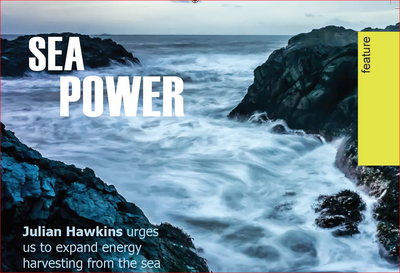Sea Power article in Summer 2018 Challenge Magazine

Julian Hawkins urges us to rethink Britain's sea power
Proposals for a barrage across the River Severn to generate electricity are regularly in the news, and tidal stream generation is also being trialled. So what is the potential of tidal power in the UK?
Tidal power is the extraction of useful energy from the ocean tides, usually in the form of electricity. Flowing water causes a turbine to spin, which drives a generator. There are two main technologies:
• Tidal barrages, where water flows into a natural bay or river.
• Tidal stream generators, where turbines are placed in a narrow point in the sea, e.g. between an island and the mainland, forcing a large flow of water through a confined space.
Tidal barrages
The amount of power available in a barrage is roughly proportional to the square of the tidal range - the height difference between low and high tides. This varies a lot from place to place but the UK has some of the highest tidal ranges in the world. In particular, the River Severn has the well known tidal bore, because of the way that the tide is concentrated by the Bristol Channel, and could generate 10 Giga Watts of power.
Tidal barrages
Tidal stream power is roughly proportional to the square of the water speed. Again, the UK has a disproportionate number of good potential locations, particularly around the Scottish islands. It isn't enough just to generate power; it needs to be distributed to consumers when they are able to use it.
Tidal power is generally:
• Non-dispatchable - ie: it can't normally be switched on and off as required
• Intermittent - only available for parts of the day at any one site, and power varies by about a factor of 4 over a fortnight (spring and neap tides)
• Predictable - tidal power at a particular site can usually be calculated fairly accurately for years ahead, though it can vary a bit in extreme weather (e.g. storm surges) The intermittency issues which affect wind and solar power are also relevant to tidal power. High tide times vary around the coast, so it might be possible to produce some baseload power all the time by using generators at many sites.
There is a limit to the amount of Wind, Solar and Tidal power which can be easily integrated to provide power on demand. Too much, and we will have surplus power at times, but run short at other times - unless we engineer the system to handle this. In the UK this challenge is mitigated by the use of gas turbines, which can be turned on and off quickly. Up to a point, we can increase renewable power penetration within the limits of existing infrastructure. Intermittency does not affect Hydro, Biomass or Geothermal. Note that it is possible to design tidal barrages with multiple basins, which would provide some control over when power was generated - at extra cost. There is some potential for adverse impact on the environment, such as turbine blades striking fish directly, or changing the shape of the coast. However, any large power source has disadvantages, and we need to offset these against the impact of global warming, and the other benefits of increasing locally generated renewable energy: economic, resilience, local empowerment. Allowing for cost, intermittency and potential adverse impacts, tidal power has the potential to make a useful contribution to power in the UK. We will need to experiment with the technology to confirm likely cost - this may or may not come down in the same way as the costs of wind and solar have declined. The greatest potential benefit could be to produce a useful amount of baseload power - if that is practical - as that is one of the main constraints on moving to a zero-carbon economy.
The Moon, the Sun and the Tides
It is often said that the tides are caused by gravitational pull of the Moon. More accurately, they are caused by the rate of change in that pull over distance - the furthest point on Earth is about 8,000 miles further from the Moon than the closest point, and gravity declines with the square of distance. If not for the effect of land, the result would be two tidal bulges sweeping around the Earth: one at the point closest to the Moon, the other on the opposite side, in about 24 hours 50 minutes (one Earth day plus a bit of extra time to catch up with the Moon, which orbits the Earth in 27 days). As there are two bulges, high tides would be 12 hours 25 minutes apart. The Sun also raises tides on the Earth, but they are much weaker. The net effect is to strengthen the tides when the Sun and Moon are lined up (same side or opposite side), and to weaken the tides when they are at right angles in the sky. These are the Spring (maximum) and Neap (minimum) tides.
There is also a small effect due to centrifugal force arising from the rotation of the Earth/ Moon system about a common barycentre, just below the surface of the Earth. This slightly increases the size of the tidal bulge opposite the Moon.
Tides around the world and in the UK
In practice, land and shallow seas obstruct the free flow of water. The result is a complex series of tides in different places, sometimes stronger, sometimes weaker, rather than the simple description above. Times of high tides vary a lot from place to place, even in a small country like the UK. The North Atlantic has some of the strongest tides, hence the interest in tidal power in the UK, and the existing generator on the Rance estuary in Brittany. In some places the shape of the land concentrates tidal flows, by channelling them into a confined area, such as the Bristol Channel. There are also narrow sea channels where this occurs, such as the Alderney Race, between the island of Alderney and the French mainland.
The best sites for tidal barrages in the UK are on the West of England and Welsh coasts. The Severn estuary represents about half the potential power available. This is relatively close to the main demand for electricity: South East England and the Midlands. The best locations for tidal stream are mainly around the Scottish Isles, further from the main demand.
UK Renewable Energy Potential
Estimated values of UK practical resources for some renewable energy sources in TWh (terawatt hours) per year:
- Solar PV 140
- Hydro 8
- Tidal Barrage 40
- Tidal Stream 18-200 Wave 40
- Onshore Wind 80 Offshore Wind > 400
- Deep Geothermal 35
It should be pointed out that deep geothermal is not yet up and running in the UK though it is working successfully in other countries; eg: the Rittershoven Geothermal plant in Alsace, which has been running since 2016 with an installed capacity of 24MWth. To contextualise those renewable energy resources, total UK electricity demand was 350 TWh in 2017, and total UK electricity production was 336 TWh. The difference was made up by net imports of electricity, in particular from France
Relative energy costs
The following costs were published by the Department for Business, Energy & Industrial Strategy in 2015 - these are "Levelised cost estimates for new generation projects begun in 2015, £/MWh" By comparison, cost of electricity for a recently promoted scheme for the Severn barrage -
- Energy Source £/MWh
- Biomass 87
- Coal with carbon 110 capture storage (CCS)
- Combined Cycle 66
- Gas Turbine (CCGT)CCGT with CCS 110
- Nuclear PWR 93 (pressurised water reactor)
- Onshore Wind 62
- Offshort Wind 102
- Solar PV, large scale 80
"Hafren Power's written evidence suggested a figure of approximately £160/MWh for the first 30 years (its business case refers to an initial price "in the range between offshore wind and nuclear") which would fall to £20/MWh for the remaining 90 years of the barrage's lifetime."
Surplus Energy, Baseload and grid integration
The main problem with Intermittent energy sources is matching supply to demand. This leads to two specific issues: surplus energy when supply exceeds demand, and the potential for blackouts when supply cannot keep up with baseload - the minimum level of demand on the grid over a period of time. These issues are often raised by the anti-Renewable Energy (RE) lobby. They aren't a problem in the UK at present, as the proportion of power generated from intermittent renewables is still fairly low in the UK but this issue will become more important in future as RE increasingly substitutes for other power sources.
A number of solutions exist: storage in batteries, pumped hydro power, and/or centrifuges; dispatchable renewable power sources such as hydro, biomass and geothermal; and the use of surplus power in Power-to-X. Numerous examples of these solutions are found around the world from the molten salt towers used to store solar energy in Spain and Nevada in the US, to the giant 100MW Tesla battery in South Australia. There are at least 18 power to gas pilots underway in Germany as the EU ramps up the switch to a renewable future. At present pumped storage - eg: pumped hydropower, where water is pumped behind a reservoir and then released through a turbine - is the main technology for storing electric power globally (around 96%). Power-to-X would use sunny days and windy nights to generate large amounts of useful fuels (such as methanol) and chemicals (such as ammonia). Across the EU, the X getting most attention is hydrogen. The faster these storage technologies can be widely adopted the sooner tidal power can transform the UK's energy supply.

- NewsFacebook Comments page
- Return to GLD Summer 2018 Challenge magazine contents page